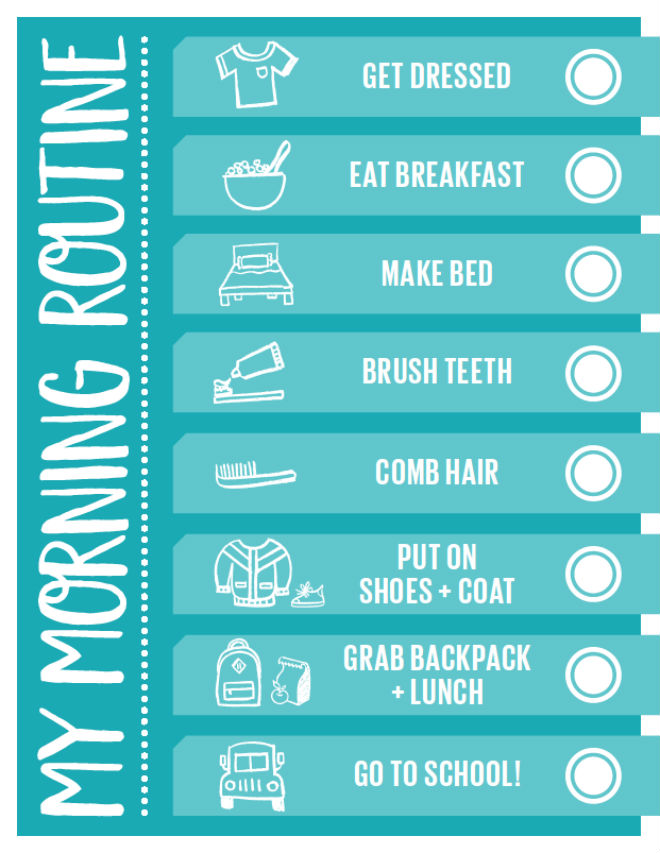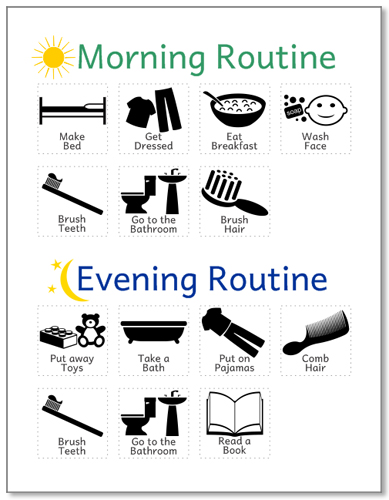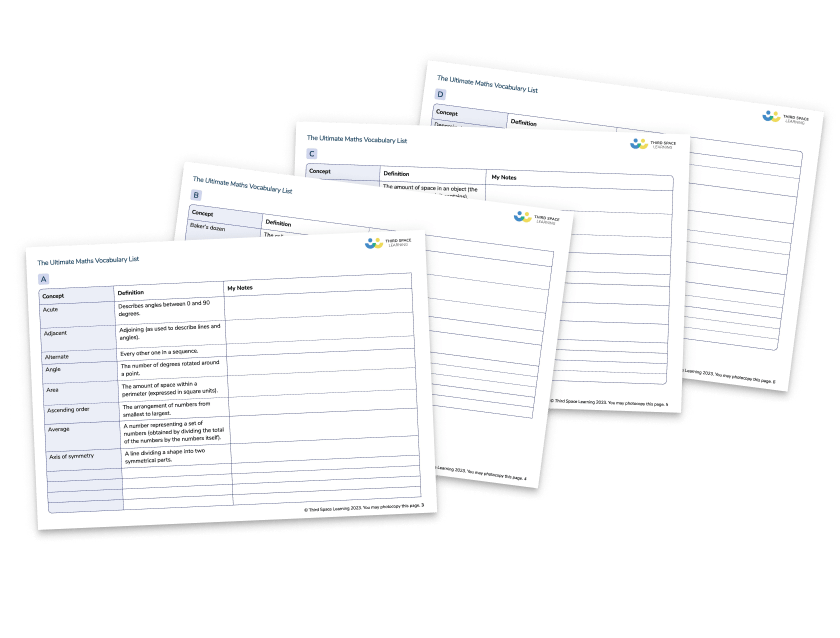How You Can Create Amazing Before & After School Routines For Your Child
As we all know, the before-school routine can feel almost impossible at times, and the only thing that can rival it is the after school routine! Getting the kids up, dressed, fed, and out of the house for school in the morning can be stressful, especially if you’re also rushing round to get yourself ready. However, you will be pleased to hear that it doesn’t have to be.
By simply implementing a good before school routine, you will find that not only your children’s but indeed your whole family’s, mornings will run much more smoothly.
The same of course applies to your after-school routine when kids return home with homework to be done, and empty tummies to be filled, and in some cases, this can be as difficult to navigate as the morning routine, albeit with slightly looser time restraints.
This raises the question of “what do good before and after school routines actually look like?”
To help you work out the right answer to this question for your family, we have put together some tips to help you create your own morning and after-school routines that will get your family through the day with minimum fuss, and help to keep your stress levels down.
The before school routine – Methods to master the mornings!
Here are a few pointers to bear in mind when creating your own stress-free morning routine:
Tip 1: Prepare as much as you can the night before
It may sound obvious, but preparation the night before really is the key to making sure you’re able to leave the house on time in the morning.
A good before school routine helps you to reduce how much you have to do before rushing out of the door, especially the more arduous tasks like ironing school uniforms, or preparing school lunches. Consider doing the following tasks as part of your evening routine:
- Pack lunches: Prepare and pack their lunch bag the night before and keep it in the fridge overnight, then all you’ll have to do is grab it and go. If you know your child has a favourite sandwich or lunchtime meal, you could also consider bulk preparing a few days worth in one go to again save time. If you are already slicing cheese for one sandwich, you may as well slice it for 2 or 3!
- Sort uniform: Wash and iron any uniform that is needed the next day, and either hang it or lay it out somewhere in your child’s room, at their level, so they can quickly get themselves dressed in the morning. If you have the time, hanging the weeks worth of shirts/trousers/skirts in the wardrobe so that they are ready to go can be a real time saver on a busy school day morning. You can then mention to your child that their uniform is ready for the entire week, and this will help them to be prepared too!
- Organise the essentials: It can be helpful to have a dedicated box, hook or shelf in your hallway or another area of the house to store all their school essentials. Knowing where everything is kept will help avoid the dreaded last-minute searches for backpacks, lunch bags and school folders in the morning, more often than not just as you are about to head out of the door. This tip applies to your belongings too. It’s hard to encourage your kids to keep all of their things in a designated place if you are guilty of spending every morning shouting “where’s my phone/wallet/keys?” to your partner!
- Prepare breakfast: If you can, try to prepare breakfast the night before, even if that just means putting cereal and bowls on the table. Having breakfast items ready to go will help the morning run more smoothly, and there will be fewer cries of “I can’t find the cereal” floating through the air come 7.30am.

Meet Skye, the voice-based AI tutor making maths success possible for every student.
Built by teachers and maths experts, Skye uses the same pedagogy, curriculum and lesson structure as our traditional tutoring.
But, with more flexibility and a lower cost, schools can scale online maths tutoring to support every student who needs it.
Watch Skye in actionTip 2: Create a morning routine for school checklist
A morning routine checklist is a great tool to help everyone remember what needs to happen in the morning and in what order. If you have younger kids, use pictures instead of just words in your morning routine chart and include all of the things that need to get done, such as:
- Get dressed
- Eat breakfast
- Brush teeth
- Wash face
- Comb and tidy hair
- Put on shoes and coat
- Grab backpack and lunch
- Go to school!
If you’ve got older children you might want to include some of the following as older kids often eat more quickly than younger ones and it’s amazing what they can then fit into their extra 15 minutes. Things you could add into the list include:
- Music practice – 10 to 15 minutes a day at primary age is all it takes to get started
- Any responsibility based chores such as making their own bed, or loading the dishwasher after breakfast to help out
- Homework time – if you make it a habit they’re less likely to complain
- Additional maths or English support – lots of parents also take this time just to do a little low stakes maths or English boosting such as doing some vocabulary work (find a word, work out its synonym, antonym, and then a sentence using it) or mental maths or arithmetic work. If you are looking for somewhere to start with this, Third Space Learning has lots of free home learning resources on the Maths Hub.
- Reading – don’t underestimate the importance of reading at all ages; if it’s not already part of your children’s lives, make time for it in the before school routine.
- A moment to relax and prepare for the day ahead – As much as this post is all about helping you create a routine and plan your day out, it is equally as important for your child to do the same. If you have some spare time during your morning routine, sit down with them and discuss what is coming up in their day and help them plan it out. Talking them through their daily routine is a great way to open a dialogue and talk through any worries that your child may have.
There are lots of great free printable morning routines online at Pinterest, or you could get your kids involved and make your own. Once you have designed a before school routine that works for your family, go through all of the steps with them, talking about each step as you go.


Doing this will help you recognise any glitches or perhaps the need to re-order some of the steps. You could aim to include 5-10 minutes of free time as a reward once all the steps have been completed. Give it a try at your house – you’ll find that using family routines is a great way to get organised!
Tip 3: Get up before your kids
This may sound easy in theory, but can be harder in practice. No matter what time you put them to bed, we all know some kids are up and bouncing around before the crack of dawn, and this can put a dent in even the most well organised morning routine!
However, in an ideal world, you will be showered, dressed, and packed up for the day by the time your little ones awake. Aim to set your alarm for at least 15-30 minutes before your children usually wake up, or longer if possible, to give you a few precious moments of “me time”.
If you’re feeling really organised you might even be able to fit in drinking a peaceful morning coffee, doing ten minutes of yoga, reading something inspiring, listening to a podcast or writing in a journal. You’ll feel so much better for it and once a week or even once a half term is better than nothing.
The after school routine: Helping with homework and hunger!
KS2 Maths Games and Activities Pack
A FREE downloadable games and activity pack, including 20 home learning maths activities for KS2 children to complete on their own or with a partner.
Download Free Now!Okay, you’ve made it through the school morning routine – so the question now becomes how best to navigate the after school regime?
The following tips aim to help you put in place a flexible after school routine that allows your kids some time to wind down after a big day at school before moving onto the homework and activities that follow.
Tip 1: Prepare for school pick-up
Again, preparation for after school is key! Your kids are likely to be tired and hungry after a long school day, so consider packing a couple of healthy snacks for the journey home. A banana, mini box of dried fruit or low-sugar cereal bar should fill the hole without filling them up too much before tea.
Walk home if you can, as this will give you time to chat about their day and give them a restorative blast of fresh air (whilst hopefully leaving them worn out enough for a good night’s sleep!)
Some children might emerge from the classroom with a ton of pent-up energy to burn off – ignore it at your peril! A quick race around the park, or biking or scooting home should keep that post-school need for speed in check and calm them down by the time your key is in the front door.
If you are feeling very adventurous, why not squeeze in a race with your child on the way home? After all, it’s never too early to begin preparing for the parent’s & carer’s race on sports day…
Tip 2: Create an after school routine chart
As with the morning routine, consider creating an after school routine chart that works for your family. This could include the following tasks:
- Hang up coats and bags
- Unpack school books
- Get changed out of school uniform
- Eat a snack
- Do homework
- Help with the washing up
- Take a bath
Something as simple as having a designated place for coats, bags and school books can be helpful, as this avoids them getting dropped in random places around your home!
If your kids have after-school activities such as sports or other clubs to go to, encourage them to get changed into their kit, and if they haven’t eaten on the way home, offer them a snack and a drink.
If your kids are anything like mine, they probably won’t be keen to answer lots of questions about their day. They will have done so much, so instead of “What did you do today?”, specific questions such as “Who made you laugh today?” or “What games did you play at lunchtime?” can work well and get them talking in their own time.
Tip 3: Make time for homework and additional learning
Having a set time for homework can be helpful, whether this is before dinner or after-dinner, so decide what works best for your family and stick to it.
After a hard day of being a primary school student, often the last thing your child is going to want to do is more work, so by adding a dedicated time period in which they should do home learning to their after school routine, it will become part of the day and much less of an issue.
DO YOU HAVE STUDENTS WHO NEED MORE SUPPORT IN MATHS?
Skye – our AI maths tutor built by teachers – gives students personalised one-to-one lessons that address learning gaps and build confidence.
Since 2013 we’ve taught over 2 million hours of maths lessons to more than 170,000 students to help them become fluent, able mathematicians.
Explore our AI maths tutoring or find out about one to one tuition for your school.







